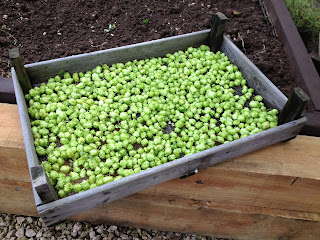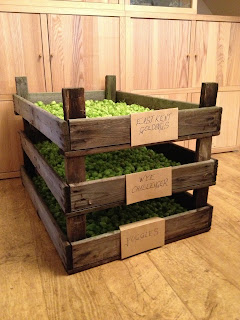Upon the northern side of Badger's Holt, we have a sizeable area which is to be maintained as a fire-break between the woodland and the adjacent farm which we call 'The Meadow'. It's not really much of a meadow in the true sense of the word, its more an area of the land which wasn't planted with trees and left to go fallow. It's heavily rutted and overgrown with a multitude of grasses around 2' to 4' high in places with brambles tucked away into the north western corner. Along the northern boundary there are two old ash trees which have suffered disease and/or lightning strikes in the past, and now the barren branches provide suitable perches for the pair of buzzards often seen. A scattering of hawthorn, elder and blackthorn bushes form a partial boundary between both ash trees, and provide a source of food and shelter for the badgers which live in an extensive sett which occupies an area of around 100 metres by around 25 metres at its widest point. Maintaining the Meadow as a fire break is not an issue for us as we plan to cultivate this area (to a degree at least) in the next year or so so that we can have a decent size parcel of land to grow fruit and vegetables for our own use, and maybe for bartering if the opportunity arises. Gem has plans for a sizeable part of this area to be turned over to the production of potatoes and carrots on a rotation (Porter has a two furrow plough which should be able to turn the sandy soil with ease, we just need a rotavator and cultivator and we should be all set), whilst I have been harbouring a desire to plant a few apple trees against our boundary with the farm, with maybe a couple of rows of hops if the location proves to be suitable.
Anyway, I digress...
The one outstanding feature of the Meadow which makes it such a highlight of Badger's Holt has to be the view:
The morning after the first night I slept in the wood, I made myself a mug of Oxo on the embers of the dying fire and wandered out through the trees towards the blazing sun until I reached the edge of the meadow, where I sat in the very spot above, for an hour or so marvelling at aerobatics of the two buzzards soaring over the valley below. After spending many hours in this spot since, it seemed only fair to create a path to it along the verge of the woodland and install my very own perch....
The construction of the bench was really quite straightforward; The cross section of the post being 7", my plan was to have two posts side by side laid horizontally, making the thickness (depth) of the bench 14", with a total height of 21" from the base of the foundation which was to be made from sections of the posts. I cut 14" off each end of both posts, which provided four 14" by 7" blocks to bear the two seat beams.

Once everything had been cut and transported down to the woods, I needed to strim a decent pathway to get the materials to where they were needed through the undergrowth.
Unfortunately, there is currently no tractor access to this part of the woodland, so Porter took a well deserved rest:
As you can see, it looks exactly how you'd expect a field which hasn't been mowed in fifteen years to look!
Once I'd strimmed out a path and identified any potentially ankle-twisting ruts, I brought up the materials and began to sink the two bearing blocks into the sandy soil to around 4" below ground level. Based upon my previous experience when excavating post holes earlier in the year, this was completed in a jiffy.
Once I was certain the bearing blocks were even and level, the simple building-block construction rattled on towards completion:
As you can see, it was a simple and straightforward project. The majority of the graft involved with this was carrying the materials through the woodland to the site, and cutting the beams to size. In future I may drill down through the beams and into the uppermost blocks on both size and drive a dowel in to prevent any movement, but to be honest the weight is sufficient that I think it'll hold as it is.
A simple tidy bench built from £15 worth of fence posts.....























